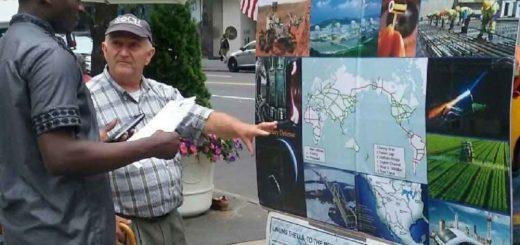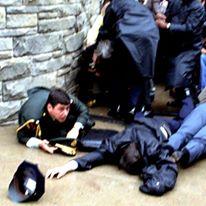EIR Daily Alert Service
|
THURSDAY, DECEMBER 29, 2016 Volume 3, Number 91 EIR Daily Alert Service P.O. Box 17390, Washington, DC 20041-0390
EDITORIALPutin Has Transformed Southwest Asia and East Asia Towards Development—Will America Follow?Dec. 28 (EIRNS)—As Obama continues to prove himself to be “politically deceased,” as Lyndon LaRouche put it, throwing thunderbolts from his political coffin as if he were still the “killer king” of old, President-elect Trump issued a Tweet today denouncing the “many inflammatory statements and roadblocks” coming from Obama. Indeed, Obama proclaimed that he would soon announce “retaliatory measures” against Russia for Putin’s imagined stealing of the U.S. election, hoping he can undermine the Trump team’s intention to end the madness. But Putin has not been wasting his time fussing with the U.S. election. The entire Mideast has been transformed by his successful intervention in Syria, which has reversed the onslaught of the Saudi-British sponsored terrorist networks. The process of destruction against Iraq, Libya and Syria—the three strongest secular, anti-terrorist nations in the region, has come to an end. In the process, proof of Obama’s arming of the terrorists is showing up everywhere—Russian sappers clearing mines from liberated Aleppo today announced the discovery of a terrorist arms depot stocked with U.S., German and Bulgarian weapons, while Turkish President Erdogan announced that he had firm evidence of U.S. arming of ISIS itself. But more important, the combination of the Russian role in Syria and Putin’s recent visit to Japan has transformed both regions, uniting them behind the reality of a new paradigm based on development. Austrian Mideast expert Karin Kneissl today made the insightful point that Russia’s ability to help the Syrian government crush the terrorist threat was dramatically aided by China’s “soft power strategy,” bringing the New Silk Road into the region, creating development and jobs for the millions of youth whose future had been stolen by the Bush and Obama wars, and creating the potential for the return of the millions of refugees to productive employment in their homelands. Lyndon LaRouche pointed today to Putin’s highly successful visit with Japanese Prime Minister Shinzo Abe this month, setting in motion huge joint development projects in the Russian Far East, and even on the contested Kuril Islands, preparing the way for a peace treaty between Russia and Japan. “This is not some local deal,” LaRouche said. “It will stimulate growth not only across Asia, but it will stimulate the world.” Abe visited Pearl Harbor Tuesday with President Obama, where his statements against any more wars could only be taken as a warning to the U.S. not to follow Obama’s insane confrontation with Russia, but to join with Japan and with China’s New Silk Road process to create a new, peaceful development paradigm for mankind. The LaRouche Political Action Committee is now preparing an updated report on “The United States Joins the New Silk Road—A Hamiltonian Vision for an Economic Renaissance.” The report will review the incredible pace of development projects initiated worldwide during 2016 under China’s Belt and Road Initiative and related efforts by Russia and India, and pose to the American people, and the Trump team, that the United States can and must participate in this revolutionary process. Not only can a revived U.S. industry contribute greatly to these global projects, but the decaying U.S. infrastructure can itself be rebuilt, with new large-scale projects in power, water, transportation, a revived space program, and scientific research into the frontiers of human knowledge. The power of the financial oligarchy, which had imposed its will on the world, has now lost control of most of the world outside the trans-Atlantic nations, and its power there is up for grabs. The bankruptcy of their financial cartels can no longer be postponed, and their populations are in a state of revolt, dismissed as “populism” by the discredited oligarchs. The rage against their evil austerity policies, and against their drive for war against Russia and China, is evident everywhere in the West. That rage must be focused into positive assertions of sanity based on LaRouche’s Four Laws approach: putting the cartels through Glass-Steagall bankruptcy procedures; creating new credit institutions on the Hamiltonian model; directing credit into the reconstruction of industry, agriculture and infrastructure; and unleashing the creative powers of our citizens to bring fusion power and space exploration on line, creating a future worthy of the dignity of man. U.S. POLITICAL AND ECONOMICU.S.-Russian Military Cooperation In Syria Expanding beyond Safety of Flight MattersDec. 28 (EIRNS)—U.S. military officials told the Associated Press, yesterday, that U.S.-Russian talks on their separate fights against the Islamic State group are becoming more productive and more frequent, with both sides trading information in real time and even outlining some of their strategic objectives in the months ahead. The AP story indicates that the two sides have overcome the animosity against Russia that is daily spewed out of White House and other places in order to focus on the situation before them. Since Dec. 15, AP reports, the U.S.-led coalition has conducted airstrikes on about two dozen locations around Palmyra, destroying air defense weapons, tanks, aircraft shelters, storage bunkers and other vehicles and equipment that had been captured by ISIS when it retook the city earlier this month. At the same time, U.S. and Russian officials having been ensuring that the two militaries’ don’t cross paths in the airspace above the city and that American strikes don’t mistakenly hit Russian or Syrian forces. But the talks have gone beyond the granular and even touched on broader U.S. and Russian plans, several U.S. officials indicated to AP. The Russians have spelled out that after they retake Palmyra, they want to move on IS militants congregated in Deir ez-Zor, which has been under ISIS siege for about two years. AP notes that while Russian President Vladimir Putin has said he hopes U.S.-Russian relations can be improved once President-elect Donald Trump takes office, “it appears some of the groundwork already is being done,” for a better U.S.-Russian relationship in Syria, even under the limitations imposed by recent acts of Congress. The U.S. military seems to be particularly concerned to avoid a repeat of the bombing of Syrian troops in Deir ez-Zor, last September, which caused the unraveling of the then-announced U.S.-Russian truce deal in Aleppo. Turkey and Russia Have Evidence of U.S.-Led Coalition Support for Islamic StateDec. 28 (EIRNS)—Turkish President Recep Tayyip Erdogan told a press conference in Ankara yesterday that Turkey has evidence of U.S. support for the Islamic State and Kurdish terror groups. “They give support to terrorist groups including Daesh (Islamic State), YPG (Kurdish People’s Protection Units), PYD (Democratic Union Party). It’s very clear. We have confirmed evidence, with pictures, photos and videos,” Iran’s PressTV quoted Erdogan as saying. U.S. Department of State spokesman Mark Toner rejected Erdogan’s accusations saying: “I don’t think anyone could look at our actions on the ground leading the coalition in northern Syria, in Iraq and say anything other than that we’re 100% behind the defeat, destruction of Daesh, and even beyond Syria and Iraq, seeing its networks dismantled, destroyed around the region—or outside of the region around the world,” Toner said. Despite these denials, Russian sappers working to demine Aleppo have found huge caches of ammunition manufactured in the U.S., Germany and Bulgaria, all NATO countries. Commander of Russia’s International Mine Action Center Ivan Gromov told Rossiya-24 TV Channel on Wednesday: “Ammunition and large-caliber small arms together with rockets for Grad multiple launch rocket systems are represented there. The shells were produced in Germany, the United States and Bulgaria.” They found 122 mm mortar shells, rockets for multiple launch rocket systems, hand grenades, grenade launchers and howitzer projectiles in one of the militants’ headquarters, enough ammunition for a whole battalion. Philippines Congress To Investigate U.S. Color Revolution PlotDec. 28 (EIRNS)—Speaker of the Philippines House of Representatives Pantaleon Alvarez called for a Congressional investigation into the blueprint exposed Tuesday in Manila Times, written by Chairman Emeritus Dr. Dante Ang, which is reported to be a detailed plan drawn up by outgoing U.S. Ambassador to the Philippines Philip Goldberg for a color revolution to depose President Duterte. According to today’s Manila Times, Alvarez said: “If true, this has serious consequences not only on our country’s political stability but also on the economic and social fabric of our nation. It would also have grave repercussions on our relationship with the United States. In view of this serious allegation I am calling for a Congressional investigation to find out if there is basis to this reported ouster plot against President Rodrigo Duterte…. That is anathema to the gospel of democracy the U.S. government, especially under the administration of President Obama, has been preaching to the world.” Alvarez said Congress could invite members of the intelligence community and U.S. Embassy staff to hearings on the alleged plot. “Of course we cannot force them (U.S. Embassy staff) but we will extend the invitation,” the Speaker said. “I was not surprised. The United States always meddles—if it has no hold over a country’s President,” Alvarez said in Tagalog. Foreign Secretary Perfecto Yasay also addressed the plot: “It is not new for Ambassador Goldberg to be accused of such a plot,” Yasay said, referring to the fact that Goldberg had been thrown out as Ambassador to Bolivia when he was caught organizing a coup against President Evo Morales in 2008. Yasay said the Manila Times report involved “a serious matter that we have to dig deeper into. I would not take this threat lightly.” The U.S. Embassy in Manila denied the existence of such a plot, and the U.S. State Department earlier denied its participation in any plans to oust Duterte. Believe it? STRATEGIC WAR DANGERRussia Ready To Re-Establish Military Ties with NATO if NATO De-EscalatesDec. 28 (EIRNS)—Russia’s Ambassador to NATO Alexander Grushko said, during a videoteleconference sponsored by the Rossiya Segodnya International Information Agency Dec. 26, that Russia is ready to restore military ties with NATO if NATO shows a willingness to de-escalate. “We consider that if the NATO member states are really interested in de-escalation in the military sphere, and their high-ranking representatives repeatedly voice this position, then one of the tasks should be to establish normal military ties,” he said, reported Sputnik. Russia is ready for this, he said, and had put forward a plan for doing so at the last NATO-Russia Council meeting. According to TASS on Monday, Grushko also ridiculed the notion, put forward very loudly and repeatedly by some parties in both Eastern Europe and Washington, D.C., that Russia has ambitions towards the Baltic states. “Any suspicions we may be harboring some aggressive designs against the Baltic countries break all reasonable bounds,” he insisted. Grushko said that NATO was going ahead with its military build-up and considering the possibility of sending troops there on a permanent, as opposed to a rotational basis. “As a result we find ourselves amid a logic that runs counter to the fundamental interests of all countries, including the Baltic ones,” TASS quoted Grushko as saying. “Regrettably, in a situation like this no diplomatic or political methods will work. This is an unreal world,” COLLAPSING WESTERN FINANCIAL SYSTEMJames Rickards to Trump—It is Glass-Steagall or BustDec. 28 (EIRNS)—James Rickards, the lawyer who negotiated the Long Term Capital Management bailout in 1998 and author of the 2011 bestseller Currency Wars: The Making of the Next Global Crisis, told MarketWatch today that Trump has but one choice to avoid the otherwise inevitable crash of the financial system: Glass-Steagall. In an interview about his new book The Road to Ruin: The Global Elites’ Secret Plan for the Next Financial Crisis, Rickards said, “The exact timing does not matter. What matters is that the crisis is inevitable and coming soon…. Since we have vastly increased the scale of the financial system since 2008, with larger banks, greater concentration of banking assets in fewer institutions, larger derivatives positions, and $70 trillion of new debt, we should expect the next crisis to be much worse than the last. The next crisis will be of unprecedented scale and damage.” He concludes, comparing Glass-Steagall actions to controlled avalanches to avoid dangerously uncontrolled ones, “The policies to avoid a systemic catastrophe in the financial system that I would recommend to the Trump administration include reinstatement of Glass-Steagall, breaking up big banks and banning derivatives. The odds of any of these policies becoming law are close to zero because of the power of bank lobbyists,” shrugging off the growing international opposition the bankrupt banks’ waning power. THE NEW GLOBAL ECONOMIC ORDERChina Interested in Pursuing Dialogue with Vatican, Official SaysDec 27 (EIRNS)—Speaking at the 9th Chinese Catholic Representative Conference in Beijing, the first time this has been assembled in six years, Wang Zuoan, the director-general of the State Administration for Religious Affairs said that China was willing to conduct constructive dialogue with the Vatican and hopes that the Vatican will take a more flexible and pragmatic attitude in such a dialogue. China’s stance on improving ties with the Vatican has always been clear and consistent, Wang said, and the country is willing to hold talks “with the Vatican based on relevant principles to narrow differences and expand common ground.” This is the first time in six years that this conference has been held, and this year the Vatican allowed its bishops to attend (in 2010 they were encouraged not to attend this meeting). The conference will select a new leadership for the Catholic Patriotic Association and the Bishops Conference of the Catholic Church. The Conference is composed of 365 delegates, including bishops, nuns, priests and laymen. One of the major issues preventing China-Vatican reconciliation is the issue of who has the right to appoint bishops, with both the Vatican and the Chinese government claiming that right. The last four bishops appointed, however, had been deemed acceptable to both parties and the foreign media are reporting that the two sides have worked out an agreement for the procedure of appointing bishops. Many of the Catholic bishops now in their dioceses have been recognized both by the Vatican and by the Chinese government. A more serious barrier to the dialogue, however, is the fact that the Vatican still recognizes Taiwan, the last European government to do so. Nevertheless, relations seem to be moving forward. Foreign Ministry spokeswoman Hua Chunying said in a daily news briefing on Dec. 26th that China has always shown good faith in promoting the improvement of bilateral ties with the Vatican. “We believe this conference can push the integration of Catholic activities into Chinese society and culture a step forward,” Hua said, noting that China was willing to continue to work with the Vatican toward progress in the constructive dialogue. Ma Yinglin, president of the Bishops Conference of the Catholic Church in China, said on Dec. 27 that the Catholic Church in China plans to set up a charity to expand its social services in the next five years. The Church also plans to increase its overseas exchanges with churches and invite overseas theologians to teach in its seminaries. There are 65 bishops, about 3,100 priests and 5,800 nuns in the Catholic Church in China, and the country has more than 6 million Catholic followers, according to the Chinese Catholic Patriotic Association. In August, Cardinal Pietro Parolin, the Vatican Secretary of State, had given a speech on China in which he indicated the intent of some elements of the Vatican with regard to the dialogue. Parolin said: “Today, as ever, many are the hopes and expectations for new developments and a new season of relations between the Apostolic See and China for the benefit not only of Catholics in the land of Confucius, but for the entire country, which boasts of one of the greatest civilizations on Earth. I would dare to say [these relations] would be beneficial even for an ordered, peaceful, and fruitful cohabitation of peoples and nations in a world, like our own, torn by many tensions and conflicts.” SCIENCE AND INFRASTRUCTUREIn Space, China Will Focus on Manpower and Industry Development and Pushing FrontiersDec. 28 (EIRNS)—In addition to summarizing the past five years’ accomplishments in space, and reiterating the major tasks for the next five, the “White Paper on China’s Space Activities” in 2016, supplemented by responses to questions at a press conference upon its release yesterday, also pose the challenges the space industry plans to meet in the near to medium term. China’s plans for its manned program, culminating in the operation of a space station in 2022, and the follow-on lunar missions for a sample return and far side mission, are well under way. But to carry out what is a highly ambitious series of missions, which also includes new series of Earth orbital satellites, ground receiving stations, frontier space science missions, and widespread economic and industrial applications, will require a significant expansion of capabilities. At yesterday’s press briefing, a reporter from Phoenix TV asked Wu Yanhua, vice head of the China National Space Administration (CNSA), “what kind of measures will be taken to build up the talent pool for the country’s space industry?” Wu responded that “we will take great efforts to promote the ‘Spirit of Manned Space Program,’ and overall space culture among elementary and secondary school students, inspiring their enthusiasm for science and motivating them to explore the unknown.” Wu also reported that “many domestic universities are working to establish an astronautics department. The growing space industry,” he added, “is also driving basic science and theoretical study further.” China Radio International asked about the contribution of China’s space development to the Belt and Road Initiative, to which Wu replied, that, based on satellites already on orbit, and those that are planned, orbital and ground infrastructure will be improved, and services in communications, navigation, and remote sensing will be made more widely available. This will be augmented by the BRICS remote sensing constellation, where each country would contribute a satellite, and “then everyone can get data from the five satellites, producing what we like to call win-win cooperation.” Asked by Reuters the perennial question on Chinese manned lunar missions, Wu explained that the first phase of going to the Moon was by the U.S. and Soviet Union. The second phase, with a focus on space science, includes Europe, Russia, China, and India. The third phase is emerging, and “Russia, Europe, China, Japan, and India are all carrying out related research. The United States, announced it would focus on Mars exploration, but Moon-related technologies are still needed in order to go to Mars, including the possible construction of a pit stop on the Moon. … As to sending man to the Moon, we are studying the feasibility of the related plans,” Wu concluded, which is the usual response on this program that the government has not yet approved. China Opens High-Speed Rail from Shanghai to KunmingDec. 28 (EIRNS)—The 2,252 km high-speed rail (HSR) connection between Shanghai and Kunming, in Yunnan Province, opened today, bringing China’s total HSR to over 20,000 km, Xinhua reports. The new route brings travelling time between the two cites down from 34 hours to 11 hours. It is the second longest in China, with the Beijing-Guangzhou line, opened in 2012, reaching 2,298 km. The government plans to extend HSR to connect every province and totalling 45,000 km by 2040. German Fusion Researchers Optimistic about Breakthrough by 2020Dec. 28 (EIRNS)—Reviewing one year of testing active plasmas at the German Wendelstein 7X experimental stellarator in Greifswald, scientists there are content with the results of their research work so far. “We are now rebuilding the tube, so that we generate pulses of up to 10 seconds,” Manfred Zohm, one of the scientists told the Deutschlandfunk radio’s science program. The next experimental round will begin in the summer of 2017, “a longer experimental campaign with maybe pulses lasting for up to 10 seconds,” Zohm explained, “afterwards there will be another restructuring, with water as coolant, and then we can do 30 minutes, which is very long.” Once that is achieved, envisaged for 2020, the Wendelstein reactor will generate a 100 million degree plasma for a half-hour, which will be the proof that a real fusion reactor much larger than this experimental one is feasible. Therefore, the future of fusion power is not so far away, actually. |
|















